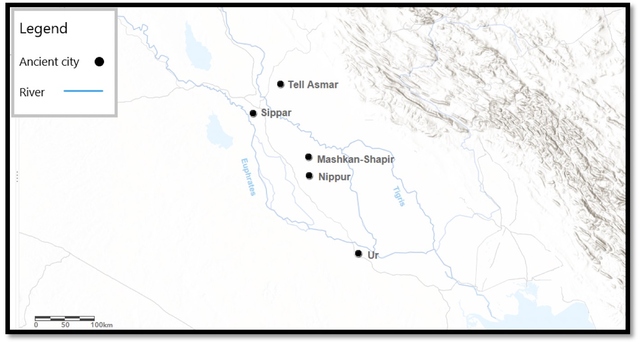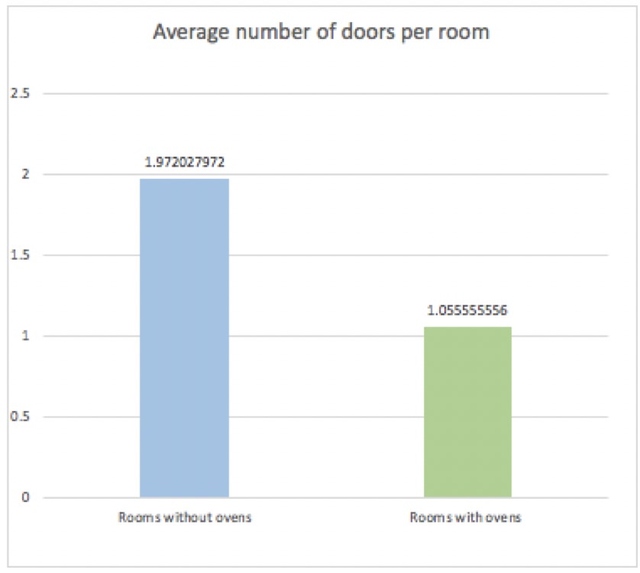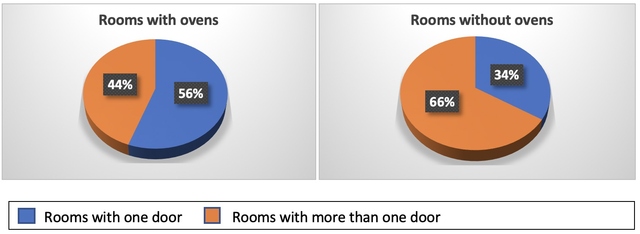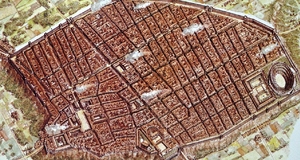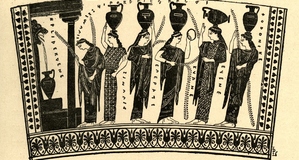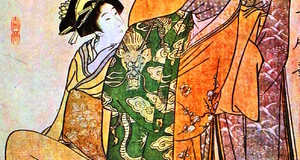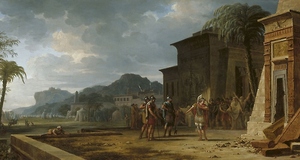Goddess in the Sheets, Prostitute in the Streets: Examining Public & Private Divisions of Gender in Mesopotamian Cities
By
2020, Vol. 12 No. 11 | pg. 1/1
IN THIS ARTICLE
KEYWORDS
AbstractThis paper explores the spatial expression of the female gender in early Mesopotamian cities from c. 2334-1595 B.C.E. Gender in Mesopotamia has been widely studied socially but not spatially, and here I aim to provide a consideration of gender through the framework of a public/private divide. Predominantly, a sensory archaeological methodology is applied to the urban environment as reconstructed by both textual and archaeological sources. This method employs Shepperson’s ‘archaeosensorium’ from Sunlight and Shade in the First Cities (2017) to study identifiable gendered spaces in the Mesopotamian archaeological record. The private sphere is viewed as the proper and preferable domain of women in this period, and sensory analysis of archaeological evidence may point towards a space that heavily restricted access and interaction. Comparatively, the facets of the public sphere examined, including streets and taverns, demonstrate a potential for female agency and subversion in such spaces. In ancient and modern societies, gender has always held influence as an intrinsic social dimension. With the development of feminist theories, the concept of ‘gender’ has come to be viewed as a construction; a societal construction that in turn, constructs society (Butler 1990). In recent scholarship, gender studies have intersected with urban theory to examine how gender acts as a constructor and construction within cities. Such studies consider gender to play an active and constitutive role in urban development (Jarvis, Cloke & Kantor 2009, p. 1; Foxhall & Neher 2012). The ancient civilisation known as “Mesopotamia” presents an intriguing landscape for the study of gender. Chiefly referred to as the land between the Tigris and Euphrates, the term ‘Mesopotamia’ describes a broad geo-temporal construction that encompasses the ancient cultures that occupied present-day Iraq and northern Syria (see figure 1). Mesopotamia inaugurated the earliest instances of writing, laws, empires and of course, urban civilisation. And yet, there has been little discussion of the constitutive role of gender in Mesopotamian cities.Cultural representations of gender in Mesopotamia were incredibly complex and remain widely debated. The number of culturally constructed genders is ambiguous, and the social expression of these genders was often fluid (Mardas 2016, pp. 22-25). Despite this ambiguity, there were evident differences in the expression and status of the male and female genders. The present paper will evaluate the spatial expression of the female gender in early Mesopotamian cities. The focus will be on the female gender and its representations, as studies of early urbanism often concentrate on male-orientated movements and institutions. The position of women in early states and cities is often approached as a question of agency (Al-Zubaidi 2004); however, in Mesopotamian studies, it is rarely approached as a question of space. To date, there is no scholarship that evaluates the gendered division of space in Mesopotamian cities. Moreover, studies of women in Mesopotamia often suffer from solely examining how women may have operated in households or temples, but not how the city was constructed around gender. The aim of this research is to survey the female experience in the urban condition through the framing of ‘public’ and ‘private’ spheres. In order to facilitate this, I will consider how newer models of sensory archaeology may elucidate spatial dynamics in Mesopotamian contexts. The chronology of this study falls between the Old Akkadian and the Old Babylonian periods, according to the traditional dating of c. 2334-1595 B.C.E. (Chadwick 2005). This includes the sub-period of Ur III, c. 2119-2004, and the Isin-Larsa dynasties, c. 1974-1763 (Chadwick 2005). While this chronology occurs after the first cities emerged in Mesopotamia, it holds the most comprehensive evidence for studying early urbanism. Fig. 1. Map of key Mesopotamian sites from c. 2334-1595. Source: author based on data from Ancient Locations (http://www.ancientlocations.net/). During the Old Akkadian period, cities greatly increased in population and size while concurrently developing sophisticated and bureaucratic systems of state administration that left behind a wealth of textual information. The subsequent Old Babylonian period, beginning around c. 2000, is considered to hold the best dataset for comparing Mesopotamian cities, as many sites were abandoned at the end of this period and excavations have uncovered extensive residential and temple complexes (Stone 2018, pp. 250-251; Ur 2012, pp. 546). Interpretive FrameworkThe city is a spatial construction. Space itself is no ‘absolute thing’- it is socially produced by the interplay of human agents and their environment (Anderson 1999, pp. 5-6; Tilley 1994, p. 10). Perception of space is fundamental to the human experience of the world, and multiple theories have emerged across different disciplines that attempt to grapple with it. Traditionally, space in cities has been analysed through the theoretical dichotomy of “public” and “private” spheres. Spaces occurring outside the household, involved with economic, religious or civic processes are typically distinguished as “public”; while interior spaces occurring within familial households are typically distinguished as “private” (Hansen 1987). The former is usually considered masculinised space, while the latter is usually considered feminised space (Hubbard 2017, pp. 120-124). Interestingly, this established dichotomy is not a product of modernity. Ideas of public and private emerged in the Graeco-Roman world, perhaps first articulated by Aristotle’s distinction between the oikos (the household) and the polis (the city) (Hansen 1987, p. 107). Public and private spaces are inextricable from the cultural frameworks they exist within. Since the late 1990s, anthropological theory has increasingly sought to examine culture through the lens of human sensory perceptions. Sensory anthropology, rejects the Cartesian division of mind and body, instead proposing a sensory interrelationship between the mind, body and environment (Howes 2005, p. 7). Such an interrelationship allows perception to be viewed qua cultural systems. Sensory anthropologists regard perception as learned behaviour that differs between cultures, as is shown by ethnographic studies of non-western societies (Classen 2005; Geurts 2002, pp. 43-48). Underpinning the theory of perception being culturally developed is the implication that humans do not always perceive or sense in the same way. Sensory studies of culture are relatively new to the discipline of archaeology. Throughout this paper, I will build on Shepperson’s innovative 2017 study, Sunlight and Shade in the First Cities, where she applied her model of ‘archaeosensorium’ to ancient Mesopotamian cities. This model is outlined as a form of sensory anthropology that considers perceptions to structure the built environment, while in turn the built environment also structures perceptions (Shepperson 2017, pp. 23-25). According to this approach, cities influence the lived experience of an individual by constructing what they perceive and how they perceive it (Shepperson 2017, p. 24). My point of departure from Shepperson is that I view urban spaces as involved in the construction of how women were perceived. In explicating space, I will consider factors in the built environment that actively structure perception, such as the implications of occupying dark or shady spaces. The Private SphereTextual TopographyAs the first urban civilisation, it is unsurprising that cities are ubiquitous throughout the Mesopotamian literary corpora. They function as more than mere background urban settings, often becoming interactive landscapes and highly evocative tropes. Look no further than the entire genre of Sumerian literature dedicated to “City Laments.” Textual evocations of Mesopotamian cities often convey a vivid delineation between the public and private spheres. Perhaps the most renowned expression of gender dynamics in the public/ private divide occurs in the Epic of Gilgamesh, when Enkidu unleashes his diatribe against the prostitute Shamhat:
Significantly, Enkidu’s first curse in the diatribe portends that Shamhat will not be able to “delight” in the domestic sphere. Positioning this specific curse at the start of the diatribe is very telling as it sets the precedent for the rest of the speech. One could interpret the diatribe consecutively, meaning that the following curses, which include Shamhat being beaten, occur because she lacks a household. Two implications emerge from this: one being that the private sphere represented spatial safety for women and secondly, that it was the more preferable domain from a woman’s perspective. As the diatribe progresses, the terms used to portray Shamhat are often explicitly spatial. She is unable to sit ‘in the young women’s chamber’ and instead sits at the ‘junction of highways’ (George 1999, 7.108-116). She is cursed to sleep in ‘a field of ruins’ and stand in ‘the shadow of the rampart’ (George 1999, 7.116-118). All these cursed places are overtly public, illustrating that being outside the household was a dire fate, if not the direst for women. Furthermore, this indicates that being relegated to the public spherewas even an undesirable experience for some prostitutes. Bottero (2001) described the encounter between Enkidu and Shamhat as evidence for the “painful destiny” of the “public woman” in Mesopotamia; confirming that for women, the public sphere was far less preferable than the private. While these lines suggest that the household was a safer and more desirable place for women, they do not necessitate that women exclusively inhabited the domestic sphere. Moreover, Enkidu seems to be suggesting that certain types of (albeit, unlucky) women did in fact circulate public spaces.However, there is further textual evidence that paints the private sphere as the proper and preferable domain for women. Several texts from the Sumerian corpus depict a space within the household called a ‘woman’s domain’, sometimes ‘women’s quarters’ or ‘women’s estate’. The phrase appears in The cursing of Agade in a couplet of similes used to portray the goddess Inanna: ‘Like a young man building a house for the first time, like a girl establishing a woman's domain’ (ETCSL 2.1.5, lines 10-24). Here the establishment of the domain is distinct from the building of the house, ergo the woman’s domain cannot be the household itself and seems to occupy an interior domestic space. A didactic text known as The Instructions of Shuruppak, also differentiates between the two: ‘You tell your son to come to your home; you tell your daughter to go to her women's quarters.’ (ETCSL 5.6.1, lines 124-125). Other instances of ‘women’s domain’ also seem to indicate a separate area within the framework of the household. This notion of domain or quarters evinces the existence of a defined physical space within the interior of the household. But can such a space be located in the archaeological record? And if so, how may we study the lived experience of its female occupants? Such questions remain difficult to investigate due to the nature of the evidence from this period in Mesopotamia; texts are often fragmented and pose potential hermeneutic problems, while the archaeological record is problematic due to the techniques used in the 1920s and 1930s when the major sites were excavated. However, I would suggest that certain textual evidence may illuminate some aspects of the female experience in the domestic sphere. In her 2016 article, Matuszak argues that Sumerian literary texts portray domestic duties as the essence of womanhood and that the most appropriate job for women was to be a housewife. This is evidenced predominantly in an unpublished Sumerian debate poem known Two Women B (2WB); in which the two female speakers insult each other about their shortcomings vis-à-vis domestic tasks. The text is the product of Old Babylonian scribal schools and is one of the few documents that deal with the nature of domestic work in Mesopotamia (Matuszak 2016, p. 229). One of the female speakers repeatedly accuses the other of ‘always buying beer, bringing readymade food’ (Matuszak 2016, p. 238). The repetition of the insult suggests the scathing nature of being incompetent in the kitchen as a woman. Matuszak analyses that bringing ‘readymade food' seems to be synonymous with a lack of care for one’s family. Inability to care for the household and family is a common theme in 2WB, and indeed, Sumerian texts seem to broadly warn against female incompetence in domestic duties. The domestic task of food preparation is relevant here, as ovens and cooking implements are identifiable in the archaeological record. Archaeological TopographyComprehending how women inhabited the private sphere requires examining whether women’s access and restriction was moderated by the very design of the household. The notion of privacy, as is connoted in the term ‘private sphere’, is often theorised as the control of access and information between people or groups (Moore 2003, pp. 216-218; Westin 1967, p. 7). If we accept that the household was the preferable domain of a woman, the next concern to address is how the Mesopotamian household controlled access and restriction through privacy. The dominant house design from the Old Akkadian to Old Babylonian period is known as the Mesopotamian courtyard house. The courtyard house reflects a residential typology in which all rooms in the complex are centred around one or sometimes multiple unroofed courts (Petruccioli 2006). Any discussion of modern or ancient courtyard houses usually acknowledges that courtyard houses prioritise privacy. In his discussion of the private residences in Old Babylonian Ur, Woolley observed that the houses were built according to an ideal type. Woolley believed this ideal was based upon three factors: climate, desire for domestic privacy, and domestic slavery (Woolley and Mallowan 1976, p. 23). Not all Mesopotamian houses were designed around an open court. The Old Akkadian houses at Tell Asmar were centred around a main room which is suspected to have been roofed. Like the courtyard, this main room was the centre of daily activities and was the space through which all other rooms could be accessed (Hill 1967, p. 148). The private houses at Tell Asmar are older than the courtyard residences at Ur and Nippur, and their differences reflect cultural distinctions between northern and southern Mesopotamia. Comparatively, however, the houses fromTell Asmar share many visual and architectural similarities with the southern courtyard types. Shepperson (2017) points out that interaction and communication depend greatly on visibility, and visibility is dictated by the available light in a space. Reduced lighting is connected with privacy in most societies and a variation of lighting within households causes inequalities in communication (Shepperson 2017, p. 128). In Mesopotamian residences, the main source of light was the roofless courtyard; the rest of the house received light through the doorways opening onto the courtyard and the street (Shepperson 2017, p. 119). What is fascinating about Mesopotamian courtyard houses, is that there is almost no evidence of windows (Van de Mieroop 1997, p. 81). Woolley explained this anomaly as a method of keeping out dust, while also maximising privacy (Woolley and Mallowan 1976, p. 24). Despite lacking an open court as a light source, the houses at Tell Asmar also demonstrate a proclivity for privacy. A clay tablet found at Tell Asmar that has been interpreted as a residential house plan, shows a preference of having only one external doorway opening onto the street (Delougaz et al 1967, Plate 65). As Hill (1967) describes, this designmost likely served the function of privacy, because there is no open court to provide light and ventilation, it seems the door was not placed there for climatic reasons. Taken altogether, I would postulate that the lack of windows and doors facing the street reflects a desire to shield the interior activities of the household from public view. Due to the methods at the time of excavations, many features of Mesopotamian domestic architecture are unidentifiable from the site plans. Fortunately, evidence of bread ovens was preserved and recorded in many of the residential houses at the Old Babylonian site of Nippur. Because there is a clear textual link between women and cooking, rooms with ovens are indicative of an area of female domestic activity. Moreover, at Mesopotamian sites, items used for spinning and weaving are often uncovered in close proximity to bread ovens (Brusasco 2007, p. 27). Spinning and weaving are also frequently depicted by Mesopotamian texts as exclusively female tasks. In 2WB, one woman denigrates the other by saying ‘she cannot comb wool, she cannot operate a spindle’ (Matuszak 2016, p. 246). Other references in 2WB also suggest that incompetence in textile work was a significant fault for a woman. Because textile work is clearly associated with women and such archaeological evidence is usually found near ovens, the placement of ovens likely points to an area where women frequented. The level of privacy in rooms where ovens are found could thus indicate how privacy shaped women’s usage of domestic space. A method often used in archaeo-spatial studies, known as ‘access analysis’, assesses the level of privacy in a room by counting the number of doors. Access analysis is based on Hillier and Hanson's (1984) study that attempted to codify social patterning of space. As light-providers, Shepperson argues that doorways in Mesopotamian houses were not merely make-shift windows. Instead, doorways would have functioned physically and symbolically as restrictors of access and interaction (Shepperson 2017, p. 128). Using Stone’s Nippur site publication from 1987, I have created a dataset to analyse the privacy of all the rooms in the residential complexes that contained ovens. I will refer to them as “oven-rooms” as there is not enough evidence to confirm their usage as kitchen spaces. These rooms were analysed according to how many doors they possess, and whether they are associated with an open space. By “open space” I refer to a courtyard or external street area. Not all the houses at Nippur contained ovens and not all the ones that did were included in this analysis. For example, House U in area TB could not be included because the excavators found no evidence of doors. 94.4 % of the rooms analysed were associated with an open space, which would increase lighting and communication to some extent. However, most rooms in Mesopotamian households were situated next to the courtyard, so this high percentage has little relevance. The most significant data came from the number of doors counted in oven-rooms. As the following graph shows, compared with the control average, oven-rooms had a lower average of doors. The control average was determined from the number of doors in all identifiable rooms without ovens. Fig. 2. Average number of doors in rooms analysed. Source: author based on data from Nippur Neighborhoods (Stone 1987). Fig. 3. Charts of counted doors in rooms. Source: author based on data from Nippur Neighborhoods (Stone 1987). This comparison alone suggests that oven-rooms had lower levels of accessibility and light. The percentage of oven-rooms that had a single door was also higher: 56% had one door. Comparatively, only 34% of the rooms without ovens had one door (shown below). The lower average of doors and the higher percentage of rooms with one door could be more than coincidental in the oven-rooms. Because doorways restricted access as well as lighting, it does seem probable that the rooms where women worked were designed to be more secluded. This lack of access is also shown in the placement of these rooms away from the entrance to the house (see Stone 1987). At Tell Asmar, the excavators noted that bread ovens were usually placed near doors. As mentioned though, these houses had no open courtyard and it is thought that the ovens were placed near the door for ventilation (Hill 1967, p. 149). Comparatively, the Nippur private houses had courtyards for ventilation, yet the placing of ovens in less accessible spaces would still increase the temperature of the house as there were no windows. Because of this, I would argue that the placing of the ovens could demonstrate a potential attempt to cloister the activities of women. Combined with the textual depictions of women’s quarters and domestic activities, it seems likely that Mesopotamian houses were designed to restrict access to women’s areas. However, I would also acknowledge that access restriction may have only been one factor of consideration in the organisation of private space; it is also difficult to evaluate the extent to which gender influenced the built environment when considered alongside other factors, such as climate and ventilation. Nevertheless, according to an archaeosensorium approach, the reason for these ostensible restrictions may be an attempt to control how women were perceived by outsiders. By limiting the number of doors in these rooms, the visibility of the occupants and objects would be decreased due to the lower level of light. The placement of the oven-rooms away from the entrances and vestibules signifies an attempt to segregate the areas where women worked from the rooms where outsiders would be received. It is possible that this spatial organization also prevented male visitors from both seeing and interacting with the female members of the house. At Tell Asmar, the houses would have been almost entirely dark due to the lack of windows and courtyards. Such a design would have restricted any onlookers from the street seeing the women going about their daily activities inside. Coupled with the evidence from Nippur, this control of visibility exemplifies a severe limitation placed on the agency of women who lived in familial households. It suggests that inside the household, women inhabited space according to how they would be perceived, if they were to be perceived at all. It is therefore not unreasonable to say that the sensory perception of women was probably a factor in the spatial organisation of the private sphere. Consequently, there may have been spatial restrictions for women within familial households. Such restrictions imply that women had limited agency in the private sphere, despite it being their proper domain. The Public SphereShifting the discussion away from the household, the following section will focus on how women were portrayed in their occupation of public urban spaces. Unlike ancient Greek and Roman cities, which used the agora and forum respectively as spheres of public matters, Mesopotamian cities have little evidence of similar designated spaces (Steinert 2014, pp.129-130). Instead, administrative, commercial, and civic matters occurred in locations throughout the Mesopotamian city, notably, the main streets, city gates, and taverns (Steinert 2011). In light of this, I will examine individual elements of the public sphere, including streets and taverns, using predominantly textual evidence. The City StreetsThe streets in Mesopotamian cities were the most extensive facet of the public sphere, as they encompassed all the entities in the city. Open spaces and streets are often challenging to study in the archaeological record, as Mesopotamian excavations have a tendency to favour buildings (Steinert 2011, p. 330). A common trend in the cities of arid regions is the minimisation of open spaces (Golany 1983, pp. 20-21). This appears true according to the planning and texts of pre-Hellenistic Mesopotamian cities, as most documents have few references to city squares, marketplaces, or assembly areas (Steinert 2011, p. 330). Steinert (2014, p. 125) specifies that while the streets served as spaces for public activities, they also symbolise a ‘negative space’ for the marginal and even threatening aspects of society. Prostitutes were perceived as marginal women, and this is signified in their occupation of streets in the textual record. Laws ¶27 and ¶30 from the legal code of Lipit-Ishtar (LL) describe a prostitute as being ‘from the street’ (Roth 1997, pp. 31-32). This familiar association appears throughout history in modern and ancient societies, although it is not clear that it began in Mesopotamia. In the Sumerian myth of Enlil and Sud, Enlil finds Sud ‘standing in the street...proudly at our gate’ and wrongly assumes she is a prostitute (ETCSL 1.2.2; Matuszak 2016, p. 233). As discussed earlier, Enkidu’s curse against Shamhat envisions the grim realities of a marginalised street-walker, forced to lurk at the junctions of highways and sleep in a field of ruins. These associations, however, do not suggest women were discouraged from circulating the streets. The texts suggest the streets only become an undesirable place for women when they are inhabited inappropriately. The Instructions of Shuruppak portrays prowling or roaming as archetypal female behaviour in the streets: ‘She’s constantly entering all houses, she’s craning (her) neck in each and every street’ (Matuszak 2016, p. 232). In some Sumerian dialogues, ‘roaming the street’ means to have no home or family; one hymn explains that women who ‘run around in the streets’ do so because they have been rejected by Inanna (Steinert 2014, p. 144). In 2WB, prowling features as an insult: ‘(You are) perpetually standing about in the city squares, and constantly prowling around in the streets’ (Matuszak 2016, pp. 232-233). While depictions may vary, clearly roaming or prowling the streets was considered a negative and yet common behaviour of women. It seems the restriction was not on women associating in the streets per se, but instead concerns temporality. The texts attest that if women spent too long in one public locale, she risked accusations of loitering, nosiness, homelessness, and prostitution. Unsurprisingly, there are no texts that chastise men for standing around. These negative connotations are yet to be considered in conjunction with non-textual evidence. Some answers may be held in archaeosensorium. As aforementioned, privacy is connected to visibility, and visibility depends on light. Visibility is dictated by vision, which is a perceptual experience. Because human beings share the same sensory perceptions, we have the potential to understand the reasoning behind the perceptual construction of spaces. The streets of ancient Mesopotamian cities are recognisably narrow, with restricted visibility (Frankfort 1950, p. 100; Woolley and Mallowan 1976, p. 15). This is a result of a deliberate shaping of the streets to mitigate the effects of sunlight. For this reason, many Mesopotamian cities, including Ur and Nippur, adopted a diagonal grid street plan (Shepperson 2009). In this form, streets run northwest-southeast and northeast-southwest to allow for a relatively equal distribution of light and shade across the city (Golany 1983, pp. 12-13; Shepperson 2009). Interestingly, streets that are orientated to receive less shade are often built to be narrow, deep and winding to compensate (Shepperson 2009, p. 367). Parallels can be observed with modern Middle Eastern Cities, that use higher walls and enclosed streets to maximise shade, creating a ‘shadow network’ (Kriken 1983, pp. 113-115). The common occurrence of this diagonal grid pattern shows a preference toward shady streets in Mesopotamian urban planning. The shady quality of Mesopotamian streets may have contributed to the negative depictions of women circulating them; for example, the limited visibility and narrowness may have provided the optimum conditions for illicit activities such as prostitution. Shepperson (2012; 2017) and Winter’s (1994) publications are the most extensive research on the connection between the symbolism of light and the Mesopotamian built environment. As might be expected, sunlight and moonlight in Mesopotamian cosmology typically connote sacredness and often endow power to a ruler or city (Winter 1994, pp. 123-124; Shepperson 2012; Shepperson 2017, pp. 50-53). Whereas, darkness and the absence of light usually symbolises danger and a loss of divine support; darkness is also associated with the underworld in Mesopotamian religion (Shepperson 2017, p. 55; Thavapalan 2018, pp. 11-12). Shade, however, is not the absence of sunlight, but involves a diminished degree of sunlight. In Sumerian and Akkadian, the words for ‘shadow’ and ‘shade’ are almost always used positively, evoking security and coolness undoubtedly connected to the necessity for shelter in an arid climate (Black 1998, p. 93). Some texts even describe shade as an evocation of divine favour, such as an army being protected by a divine shadow (Thavapalan 2018, p. 12). These positive attributes of shade conflict with the negative associations of women in the streets. It is also possible that the shade and concealment of the streets allowed women to evade the gaze of their husband or male guardian. Variations in visibility can cause inequalities in communication and access, while simultaneously expressing the power dynamics of an environment (Brighenti 2007, pp. 325-326). By occupying the less visible areas of the streets, a woman would be able to view those in more visible spaces, thus holding a dominant visual position. It is this potential for visual dominance that may have inspired the negative views and superstitions of women in the streets. The negative portrayals suggest that women were inherently untrustworthy and needed to be monitored by men. Without the watchful eyes of a male guardian in the street, women had the opportunity to engage in illicit activities, prowling and nosiness, as the texts warn. If the shady streets were perceived as benign places, then I would infer that the negative connotations reflected the cultural beliefs about women. The TavernTaverns in Mesopotamia functioned as highly public establishments, places essential for social contact and community. The most common Akkadian terms for tavern in the Old Babylonian period are bīt sābîm, house of the tapster, and its feminine form bīt sābītim, house of the tapstress (Langlois 2016, p. 113; Cooper 2016, p. 218). The actual nature of these establishments and what they entailed is somewhat disagreed upon by scholars. One point many accept, is that taverns have a bad and depraved reputation in the literature (Langlois 2016, pp. 117-118; De Graef 2018, p. 95). Cooper (2016) argues that some taverns run by female innkeepers may have been brothels, as female innkeepers frequently come under scrutiny in the law codes. Arguments of this sort are the reason taverns are often painted as establishments of criminal and disorderly conduct. In the Sumerian corpus, prostitution is often lexically associated with taverns. One hymn to Inanna narrates: ‘when I sit by the gate of the tavern, I am a prostitute’ (ETCSL 4.07.9, lines 16-22). Here the diction portrays prostitution as having an ontological relationship to taverns: when Inanna occupies space near a tavern, she becomes a prostitute. Another instance is found in The cursing of Agade, where a prostitute is described as hanging herself at the entrance to a tavern (ETCSL 2.1.5). The dominant stance in opposition with this characterisation comes from Assante’s 1998 paper, that labelled the tavern prostitute a ‘scholastic invention’ and argued taverns were relaxing, social places within Mesopotamian communities. Assante (1998, p. 68) points out that there is no law prohibiting women and children from entering taverns. Ration lists indicate that both men and women drank beer daily, not all of which could stem from domestic production (Assante 1998, p. 66). Furthermore, some documents cite taverns as providing food and medicines as well as beer, suggesting they supplied everyday essentials and a place to socialise (Assante 1998, p. 68). To some extent, Assante’s portrayal is accurate in that it does seem that taverns functioned as an essential nexus within Mesopotamian urban communities. However, other textual evidence disputes the tame aspect of such imagery. In one instance, the king Shamshi-Adad complains in a letter that deserters from his palace have left ‘for partying, for the bīt sābītim, and for carousing’ (Cooper 2016, p. 218). The associations of prostitution with taverns- which Assante disputes- also definitely suggests an ambiance of rowdiness. While I would agree with Cooper and De Graef that taverns had a bad reputation, simultaneously it appears that ordinary women were not prohibited from them. Interestingly, texts from Sippar depict priestesses as inheriting, purchasing and leasing taverns; there is also evidence that taverns were involved in the initiation rituals of naditu priestesses (De Graef 2018, pp. 95-99). The documentation on tavern ownership primarily originates from the Old Babylonian levels at the site of Sippar, with naditu priestesses being documented as the primary owners in this period (Harris 1975, pp. 20-21). The economic involvement of priestesses in Mesopotamian taverns has been thoroughly discussed by De Graef (2018) and goes beyond the scope of the present paper. However, I wouldconsider taverns to be evidence of women circulating and even dominating public spaces. As discussed, taverns ostensibly had a rowdy reputation, although there is no concern echoed in the texts about these establishments tainting the reputations of women. The archaeological evidence of taverns is slim, but according to Sippar documents, they were located usually in the city squares or on wide streets (Harris 1975, p. 20). Such positioning within the city, coupled with evidence of priestesses owning taverns, nuances the claim that the household was the only domain for a woman. Elevated Danger in the Public Sphere?These final sections will consider whether the public sphere in the period in question was considered highly dangerous for women. A perception of elevated risk in the public sphere is used in many cultures to reinforce expectations of women working in the household (Hubbard 2017, pp. 130-131). Some scholars have hypothesised that certain areas of Mesopotamian cities had an elevated risk of rape for women, including the street, the tavern and the public squares (Stol 2016, p. 263). This analysis is primarily based on Law §55 from the Middle Assyrian Code, which mentions rapes occurring in these places; however, this law code was written well after the Old Babylonian period and there are no similar mentions in the law codes dating from the earlier periods. Moreover, the Middle Assyrian Law Code depicts women as having comparatively less autonomy than in the preceding Mesopotamian codes (Roth 2014, 158). Not all the evidence from the Old Akkadian to the Old Babylonian period portrays the public sphere as dangerous. A Sumerian song The Wiles of Women features a dialogue that depicts an adolescent girl playing in the street at night (Steinert 2014, p. 128). The dialogue is between two gods, one who is a seducer (Dumuzi) and one who is a girl (Inanna); Dumuzi describes Inanna ‘strolling with me in the street, to the playing of tambourine and recorder she danced with me, we sang and time went by’ (Steinert 2014, p. 128). There are no warnings or forebodings mentioned, implying that it was culturally acceptable for young women to circulate the streets and be visible in public. Of course, a tale of deities may not accurately represent the reality of everyday people and it does not counteract other textual evidence that accuses women of prowling in the streets. However, it does challenge simplistic portrayals of Mesopotamian women lacking agency in their experience of public space. Conclusions & LimitationsAt core, the evidence presented here suggests that women were spatially restricted in both the public and private spheres of Mesopotamian cities. As the proper and preferable domain for women, the household may have been constructed to cloister areas of female activity, as is demonstrated by the placing of ovens in less accessible spaces. However, women were not prohibited from the public sphere- in fact, the evidence of female tavern ownership suggests women had the potential to even dominate public space. Archaeosensorium analyses of both the household and the streets indicate a relationship between the built environment and cultural perceptions of women. The controlling of visibility through the minimisation of light in households could indicate a proclivity to shield women from the gaze of outsiders or male visitors. While in the streets, the positive connotations of shade conflict with the negative perceptions of women inhabiting them; possibly a result of the streets providing enough cover for illicit activities. We will likely never know the extent to which gender influenced the construction of early Mesopotamian cities. And it is important to acknowledge that due to the subjective and fragmented nature of the evidence from this period, the claims made in this paper are difficult to substantiate. There is also a plethora of other possible avenues for studying gender in Mesopotamian urban environments, including examining historical periods outside the ones mentioned here and analysis of gendered constructions in religious buildings. Broader evaluation of how other social factors - such as occupation and class- impacted female agency in cities is also needed. Overall, the evidence envisions an urban landscape where women had defined social places that were embodied by defined spatial places. ReferencesAl-Zubaidi, L2004, ‘Tracing women in early Sumer’, in KA Pyburn (ed.), Ungendering Civilization,Routledge, New York, pp. 117-135. Ancient Locations: database of archaeological sites 2008, accessed 14 May 2019 . Anderson, K 1999, ‘Introduction’, in K Anderson & F Gale (eds.), Cultural Geographies, 2nd edn,Longman, South Melbourne, pp. 1-21. Assante, J 1998, ‘The kar.kid / ḫarimtu, Prostitute or Single Woman? A Reconsideration of theEvidence’, Ugarit Forschungen, vol. 30, pp. 5-96. Black, JA 1998, Reading Sumerian Poetry, Cornell University Press, Ithaca. Black, JA, Cunningham, G, Ebeling, J, Flückiger-Hawker, E, Robson, E, Taylor, J & Zólyomi,G 1998–2006, The Electronic Text Corpus of Sumerian Literature (ETCSL), accessed 1 September 2020, , Oxford. Bottéro, J 2001, Everyday life in ancient Mesopotamia, Johns Hopkins University Press, Baltimore. Brighenti, A 2007, ‘Visibility: A Category for the Social Sciences’, Current Sociology, vol. 55, pp. 323-342. Brusasco, P 2007, The Archaeology of Verbal and Non-Verbal Meaning: Mesopotamiandomestic architecture and its textual dimension, Archaeopress, Oxford. Butler, J 1990, Gender trouble: feminism and the subversion of identity, Routledge, NewYork. Chadwick, R 2005, First civilizations: ancient Mesopotamia and ancient Egypt, 2nd edn, Equinox,London. Classen, C 2005, ‘McLuhan in the Rainforest: The Sensory Worlds of Oral Cultures’, in DHowes (ed.), Empire of the Senses, Berg, Oxford, pp. 147-163. Cooper, JS 2016 ‘The Job of Sex: The social and economic role of prostitutes in ancient Mesopotamia’, in B Lion & C Michel (eds.), The Role of Women in Work and Society in the Ancient Near East, De Gruyter, Boston, pp. 209-227. De Graef, K2018, ‘In Taberna Quando Sumus. On Taverns, Nadītum Women, and the Gagûm inOld Babylonian Sippar’, in SL Bundin, M Cifarelli, A Garcia-Ventura &AM Alba (eds.), Gender and methodology in the ancient Near East:Approaches from Assyriology and beyond, Edicions de la Universitat deBarcelona, Barcelona, pp. 77-115. Delougaz, P, Hill, HD & Lloyd, S 1967, Private Houses and Graves in the Diyala Region, The University of ChicagoPress, Chicago. Foxhall, L & Neher,G 2012, ‘Introduction’, in L Foxhall & Neher G (eds.), Gender and the City beforeModernity, John Wiley & Sons, Hoboken, pp. 1-19. Frankfort, H 1950, ‘Town Planning in Ancient Mesopotamia’, The Town Planning Review, vol. 21,pp. 99-115. George, A 1999, The Epic of Gilgamesh: The Babylonian Epic Poem and Other Texts inAkkadian and Sumerian, Penguin Books, London. Geurts, KL 2002, Culture and the senses bodily ways of knowing in an African community,University of California Press, Berkeley. Golany, G 1983, ‘Urban Form Design for Arid Regions’, in G Golany (ed.), Design for AridRegions, Van Nostrand Reinhold, New York, pp. 1-23. Hansen, KV 1987, ‘Feminist Conceptions of Public and Private: A Critical Analysis’, BerkeleyJournal of Sociology, vol. 32, pp. 105-128. Harris, R 1975, Ancient Sippar: A Demographic Study of an Old-Babylonian City (1894-1595B.C.), Nederlands Instituut voor het Nabije Oosten, Leiden. Hill, HD 1967, ‘Tell Asmar: The Private House Area’, in P Delougaz, HD Hill, and S Lloyd(eds.), Private Houses and Graves in the Diyala Region, The University ofChicago Press, Chicago, pp.143-181. Hillier, B & Hanson, J 1984, The Social Logic of Space, Cambridge University Press, Cambridge. Howes, D (ed.) 2005, Empire of the senses: the sensual culture reader, Berg, Oxford. Hubbard, P 2017, City, Routledge,Milton. Jarvis, H, Cloke, J & Kantor,P 2009, Cities and Gender, Taylor & Francis, Hoboken. Kriken, J 1983, ‘Town Planning and Cultural and Climatic Responsiveness in the Middle East’,in G Golany (ed.), Design for Arid Regions, Van Nostrand Reinhold, New York,pp. 97-120. Langlois, A 2016, ‘The Female Tavern-Keeper in Mesopotamia: Some Aspects of Daily Life’, inSL Budin & JM Turfa (eds.), Women in Antiquity: Real Women across theAncient World, Routledge, London, pp.113-125. Mardas, J 2016, ‘Gender and the Archaeology of the Ancient Near East: Femininities andMasculinities’, in I Milevski & TE Levy (eds.), Framing Archaeology in the Near East, Equinox Publishing, Sheffield, pp. 21-30. Matuszak, J 2016, ‘“She is not fit for womanhood”: The Ideal Housewife According to SumerianLiterary Texts’, in B Lion & C Michel (eds.), The Role of Women in Work andSociety in the Ancient Near East, De Gruyter, Boston, pp. 228-254. Moore, AD 2003, ‘Privacy: Its Meaning and Value’, American Philosophical Quarterly, vol. 40, pp. 215-227. Petruccioli, A 2006, ‘The courtyard house: typological variations over space and time’, in BEdwards, M Sibley,P Land & M Hakmi, (eds.), Courtyard Housing: Past, Present and Future, Taylor & Francis, Oxon, pp. 3-20. Roth, MT1997, Law collections from Mesopotamia and Asia Minor, 2nd edn, Scholars Press,Atlanta. Roth, MT2014, ‘Women and law’, in MW Chavalas (ed.), Women in the Ancient Near East,Routledge, Oxon, pp. 144-174. Shepperson, M 2009, ‘Planning for the sun: urban forms as a Mesopotamian response to the sun’,World Archaeology, vol. 41, pp. 363–378. Shepperson, M 2012, ‘The Rays of Šamaš: Light in Mesopotamian Architecture and Legal Practice’, Iraq, vol. 74, pp. 51-64. Shepperson, M 2017, Sunlight and Shade in the First Cities: A sensory archaeology of early Iraq,Vandenhoeck & Ruprecht, Göttingen. Steinert, U 2011, ‘Akkadian Terms for Streets and the Topography of Mesopotamian Cities’,Altorientalische Forschungen, vol. 38, pp. 309–347. Steinert, U 2014, ‘City Streets: Reflections on Urban Society in the Cuneiform Sources of theSecond and First Millennium BCE’, in NN May & U Steinert (eds.),The Fabric of Cities: Aspects of Urbanism, Urban Topography and Society in Mesopotamia, Greece and Rome, Brill, Leiden, pp. 123- 170. Stol, M 2016, Women in the Ancient Near East, trans. H Richardson, De Gruyter, Hanover. Stone, EC 1987, Nippur Neighbourhoods, The Oriental Institute of The University of Chicago,Chicago. Stone, EC 2018, ‘The Trajectory of Social Inequality in Ancient Mesopotamia’, in TA Kohlerand ME Smith (eds.), Ten Thousand Years of Inequality: The Archaeology of Wealth Differences, University of Arizona Press, Tucson, pp. 230-261. Thavapalan, S 2018, ‘Radiant Things for Gods and Men: Lightness and Darkness in MesopotamianLanguage and Thought’, Colour Turn, vol. 7, pp. 1-36. Tilley, C 1994, A Phenomenology of Landscape: Places, Paths and Monuments, Berg,Oxford. Ur, J 2012, ‘Southern Mesopotamia’, in DT Potts (ed.), A Companion to the Archaeology oftheAncient Near East, Blackwell Publishing, Oxford, pp. 533-558. Van De Mieroop, M 1997, The ancient Mesopotamian city, Oxford University Press, Oxford. Westin, AF 1967, Privacy and freedom, 1st edn, Atheneum, New York. Winter, IJ1994, ‘Radiance as an Aesthetic Value in the Art of Mesopotamia (With some Indian Parallels)’, in BN Saraswati, SC Malik & M Khanna (eds.), Art, the Integral Vision: A Volume of Essay in Felicitation of Kapila Vatsyayan, Printworld, New Delhi, pp. 123-132. Woolley, L & Mallowan, M 1976, Ur Excavations Volume VII: The Old Babylonian Period, British MuseumPublications, London. Suggested Reading from Inquiries Journal
Inquiries Journal provides undergraduate and graduate students around the world a platform for the wide dissemination of academic work over a range of core disciplines. Representing the work of students from hundreds of institutions around the globe, Inquiries Journal's large database of academic articles is completely free. Learn more | Blog | Submit Latest in Anthropology |

